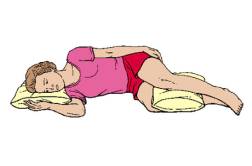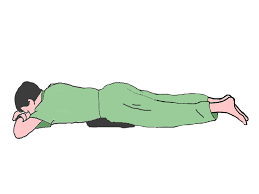|
Can a series on posture ever be complete without considering the sleeping or lying down posture? The best posture lying down is the supine posture, that is lying on your back, in anatomical position or with arms and legs relaxed and legs turned out slightly at hip joints. This enables maximum support to the body, allowing the postural muscles engaged in maintaining the upright position to relax. A pillow under the head and neck supporting the cervical curve allows muscles in this region to relax. If the hamstrings or hip flexors are tight, it helps to put a pillow under the knees to relieve tension in these muscles and maintain the spine in neutral position. In a physical therapy clinic, supine posture is employed for manual therapy on various limb joints and muscles, to train the abdominals as well as, increase awareness of diaphragmatic breathing. Side-lying is another position one can assume in recumbent position. While lying on the side, a straight (neutral) spine and slightly bent knees is ideal. To maintain a neutral spine, it may be necessary to place a pillow between the knees to prevent side bending. Yoga practitioners say lying on the left side post-lunch helps the liver function well and aids in food digestion and making one alert. Also, when lying on the left side, breathing occurs predominantly through the right nostril and when lying on the right side, it takes place through the left nostril. In a physical therapy clinic, side-lying position is employed to balance and bring awareness to asymmetries. The prone position is when one lies in face-down position, on the chest or stomach. It helps open the alveolar sacs in posterior lungs, which have a large surface area. This position may predispose to stress in the lumbar spine if the trunk muscles have decreased tone, putting uneven pressure on the inter-vertebral discs and nerve roots as they exit from the foramen. In this case a small, thin, pillow under the abdomen/pelvis helps maintain the curve in lumbar spine and prevent excessive lumbar lordosis. Also in this position, the head needs to be turned to one side, which impacts the cervical spine. In a physical therapy clinic, the prone position is employed to train the back extensors and upper quadrant muscles, including the scapular muscles and cervical extensors and in stretching the chest/pectoral area if tight. Often times prone exercises are encouraged on exercise ball, which is found to decrease trunk muscle co-contraction by nearly 1/3rd as similar exercises on a mat, and is obviously beneficial in gentle and progressive strengthening in case of back injury. A lot of studies are conducted on sleep and the profound impact poor sleep can have on an individuals’ life. Whatever the posture adopted in lying down, it is essential to be comfortable to allow deep sleep so that all the cells in the body can rest and rejuvenate. In authentic yoga, it has been observed sleep requirement naturally decreases and body rejuvenates faster and effectively with fewer hours of sleep. Ever wonder when you go to a physical therapy clinic, why there are plinths or mats? Though evaluation of posture in various positions reveal many things to the trained eye, the muscles are most relaxed in the lying position and hence allow a true assessment of the range of motion of joints and in some instances, it helps determine whether the problem lies in the joints or in the soft tissue surrounding them. In the lying position, the soft tissue and joints can be influenced and worked with employing manual therapy, allowing the individual to experience a normal functional movement and increasing awareness of the same, thus making conscious change possible. This very much determines the effectiveness of therapy and has significant bearing on the outcome. Lying down is the position which allows you to focus attention on your breath. It is very helpful in increasing awareness of dysfunction and re-training a good breathing pattern or even in aerating selective parts of the lungs by lying on one side or orienting the lungs and airways to inflate maximally. This is because the effort, which goes towards maintaining stability in an upright position such as sitting or standing, is eliminated. In other words, the surrounding trunk postural muscles relax, making it easier to shift attention to muscles and motion involved in breathing. In summary, lying down and going into restful sleep allows rejuvenation, both physically and mentally. Lying down in the wakeful stage enables one to make conscious changes to breathing, posture, and movement. As the saying goes “Let him sleep for when he wakes, he will move mountains.”
0 Comments
Your comment will be posted after it is approved.
Leave a Reply. |
Details
AuthorAmi Gandhi is a licensed physical therapist in the state of California. She is the owner of StableMovement Physical Therapy, a small boutique practice in San Jose that offers patient centered, one-on-one, hands-on physical therapy. Archives
March 2018
Categories |


